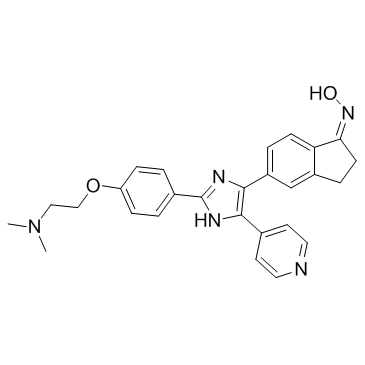| Description |
SB-590885 is a potent B-Raf inhibitor with Ki of 0.16 nM, and has 11-fold greater selectivity for B-Raf over c-Raf, without inhibition to other human kinases.
|
| Related Catalog |
|
| Target |
B-Raf:0.16 nM (Ki)
c-Raf:1.72 nM (Ki)
|
| In Vitro |
SB-590885 displays significant selectivity for B-Raf over c-Raf with Ki of 0.16 nM over 1.72 nM. SB-590885 is a more potent inhibitor than the previously described Raf/VEGFR kinase inhibitor BAY 439006 (Ki=38 nM for mutant B-Raf, 6 nM for c-Raf). SB-590885 displays potent selectivity over 46 other kinases. Unlike the multi-kinase inhibitor BAY43-9006, SB-590885 stabilizes the oncogenic B-Raf kinase domain in an active configuration. In Colo205, HT29, A375P, SKMEL28, and MALME-3M cells expressing oncogenic B-RafV600E, SB-590885 treatment potently inhibits ERK phosphorylation with EC50 of 28 nM, 58 nM, 290 nM, 58 nM, and 190 nM, respectively, and consistently, inhibits the proliferation with EC50 of 0.1 μM, 0.87 μM, 0.37 μM, 0.12 μM, and 0.15 μM, respectively. SB-590885 decreases anchorage-independent growth of melanoma cell lines in a BRAF mutant-selective manner[1]. SB-590885 displays high affinity for B-Raf with Kd of 0.3 nM[2]. Most of the melanoma cell lines that harbor the BRAF V600E mutation and lack CDK4 mutations (451Lu, WM35, and WM983) are highly sensitive to SB-590885 with IC50 of <1 μM. Increased levels of cyclin D1 resulting from genomic amplification mediate SB-590885 resistance in B-Raf V600E-mutated melanomas[3].
|
| In Vivo |
Administration of SB-590885 potently decreases tumorigenesis in murine xenografts established from mutant B-Raf-expressing A375P melanoma cells, and modestly inhibits tumor growth[1].
|
| Cell Assay |
For proliferation assays, cells are treated with compounds in 0.1% DMSO and incubated for 72 hours at 37°C, 5% CO2. Viable cells are quantified using CellTiter-Glo reagent and luminescence detection on a Victor 2V plate reader. Cells are prepared for cell cycle analysis on a Becton Dickinson FACScan, according to the manufacturer's instructions. Data is acquired and analyzed using CellQuest v3.3 software. Anchorage-independent growth assays are done as described elsewhere, with inhibitors or DMSO vehicle included in the agar layer. Cultures are re-fed with media and inhibitor or DMSO every 5 to 7 days for a total of 28 days. Colonies are visualized and photographed by conventional light microscopy and quantified by counting on a grid in triplicate.
|
| Animal Admin |
The pharmacokinetic properties and safety of SB-590885, following i.p. injection, are determined and 50 mg/kg daily injections are found to give therapeutic levels with minimal body weight changes. Tumors are initiated in 8- to 12-week-old female nude mice by s.c. injection of 5×106 A375P cells in Matrigel suspension, and 3 weeks after tumor induction when the tumors had reached a volume of 150 to 250 mm3, mice are randomized into groups of eight prior to treatment. Animals are treated with vehicle [2% N,N-dimethylacetamide, 2% Cremophor EL, and 96% acidified water (pH 4-5)], or vehicle containing 50 mg/kg of SB-590885 daily for 21 days. A cohort of mice treated with SB-590885 are then observed an additional 14 days following cessation of treatment. Tumor volume is measured for 55 days by calipers twice weekly.
|
| References |
[1]. King AJ, et al. Demonstration of a genetic therapeutic index for tumors expressing oncogenic BRAF by the kinase inhibitor SB-590885. Cancer Res, 2006, 66(23), 11100-11105. [2]. Takle AK, et al. The identification of potent and selective imidazole-based inhibitors of B-Raf kinase. Bioorg Med Chem Lett, 2006, 16(2), 378-381. [3]. Smalley KS, et al. Increased cyclin D1 expression can mediate BRAF inhibitor resistance in BRAF V600E-mutated melanomas. Mol Cancer Ther, 2008, 7(9), 2876-2883.
|
